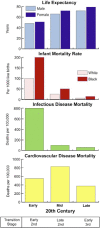The changing disease-scape in the third epidemiological transition
- PMID: 20616997
- PMCID: PMC2872288
- DOI: 10.3390/ijerph7020675
The changing disease-scape in the third epidemiological transition
Abstract
The epidemiological transition model describes the changing relationship between humans and their diseases. The first transition occurred with the shift to agriculture about 10,000 YBP, resulting in a pattern of infectious and nutritional diseases still evident today. In the last two centuries, some populations have undergone a second transition, characterized by a decline in infectious disease and rise in degenerative disease. We are now in the throes of a third epidemiological transition, in which a resurgence of familiar infections is accompanied by an array of novel diseases, all of which have the potential to spread rapidly due to globalization.
Keywords: degenerative disease; epidemiological transition; globalization; infectious disease.
Figures


References
-
- Armelagos GJ, Barnes K. The evolution of human disease and the rise of allergy: Epidemiological transitions. Med. Anthropol. 1999;18:187–213.
-
- Armelagos GJ, Barnes KC, Lin J. Disease in human evolution: The re-emergence of infectious disease in the third epidemiological transition. AnthroNotes. 1996;18:1–7.
-
- Barrett R, Kuzawa CW, McDade T, Armelagos GJ. Emerging infectious disease and the third epidemiological transition. In: Durham W, editor. Annual Review of Anthropology. Vol. 27. Annual Reviews Inc; Palo Alto, CA, USA: 1998. pp. 247–271.
-
- Omran AR. The epidemiologic transition: A theory of the epidemiology of population change. Milbank Q. 1971;49:509–538. - PubMed
-
- Omran AR. A century of epidemiologic transition in the United States. Prev. Med. 1977;6:30–51. - PubMed
Publication types
MeSH terms
LinkOut - more resources
Full Text Sources
Medical

